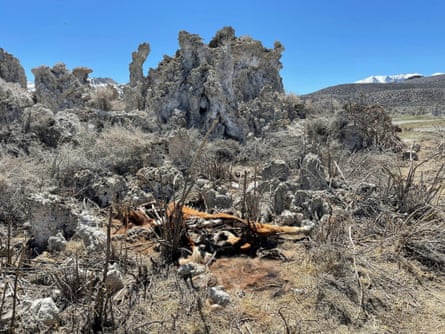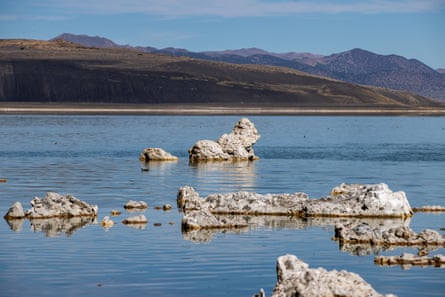
East of Yosemite national park, Mono Lake is an ancient body of water, home to millions of brine shrimp and waterfowl and providing stunning views. It’s also home to a herd of more than 500 wild horses that began arriving in the area around 2015.
This spring, as snow drifts from a record-setting winter storm began to melt, officials were surprised to find the horses turning up dead.
“Visitors should be prepared to come across horse carcasses and manure,” officials with the Inyo national forest posted on Facebook in mid-May, saying there had been reports of “several horse carcasses” around the lake, accompanied by unsettling photos of skeletal remains.
Experts believe the harsh winter conditions are likely behind the deaths, putting a spotlight on the precarious relationship between the horses and this rugged landscape – both in terms of the dangers it poses to them, and the dangers they pose to it.
Horses are a potent symbol of the wild nature of the US west, but they also pose environmental hazards as their numbers swell. Wild horses, descendants of European horses, are not native to North America. In the Mono Lake basin, their presence has already created problems.
The established territory for the herd is about 20 miles (30km) south of the area, says Lisa Cox, a spokesperson for the US Forest Service, and the number of horses has grown in number in recent years. When they began arriving in 2015, the herd numbered about 45-50; last fall, an aerial survey counted 570 on the lake’s east shore. The Mono Lake area is a saline environment, which is not their typical habitat, Cox says. “They are looking for food, looking to expand, and now in territory they have’t been in before.”
According to the Bureau of Land Management (BLM), the horses in the Mono Lake basin belong in the Montgomery Pass herd management area – a home range of 50,000 acres (20,000 hectares) of mixed public lands located primarily in Nevada, about 30 miles (50km) east of Mono Lake.
The horses leave behind manure – and that can become problematic for the delicate environment. The lake has a number of wetlands and alpine meadows, fragile habitats that have been without horses for 13,000 years – so they have evolved and adapted to shorebirds and waterfowl and plants, says Bartshe Miller, the eastern sierra policy director at the Mono Lake Committee. “The horses are changing the environment, denuding the spring areas, likely increasing evaporation and turning it all into grasslands,” he says.
Geoff McQuilkin, executive director of the Mono Lake Committee, says if the horses keep growing in number and pushing west, they will soon meet big highways – which could be dangerous for both people and animals. That’s why the forest service is starting to study what the carrying capacity – that is, the sustainable population – of the area might be.
In a good year, the horses might be able to find plenty to eat, but when conditions are harsh – in a drought or after a heavy snowfall – horses are going to struggle, and also push into more areas. “There’s a real concern not just for the horses but for the lake as well and also public safety,” McQuilkin says. One biker already collided with a horse, and was left with serious injuries.
after newsletter promotion

Cox says the high snow drifts this year probably prevented the horses from finding food. “Basically, if they can’t paw their way through the snow to get the vegetation to feed on, it forces them to migrate outwards and look for other sources of food,” she says, adding that the specialists from the forest service saw evidence that the horses were feeding on rabbitbrush, a flowering bush that is not a main food source for wild horses. “That is kind of telling – they were probably really hungry.”
Wild horses are a federally protected animal which, alongside bald eagles, are one of only two species with such a special level of protection. In 1971, wild horses were fast disappearing, and Congress passed the Wild Horses Act. Since then, their numbers have skyrocketed – there are 82,000 roaming free and 64,000 in holding facilities, according to the the American Wild Horse Campaign.
The nonprofit group advocates for tools like birth control as a humane way to manage wild populations on public lands. In the case of Mono Lake, Grace Kuhn, a spokesperson for the the American Wild Horse Campaign, said a long-term plan is needed to maintain a balance between the population and a sensitive landscape.
“They’re beautiful animals. I see why people get very emotional about them,” says Miller, who agrees on the need for more planning. “And in large numbers, they can do a lot of damage. So I think the point is to have a plan that protects the lake, the resources and public safety. And right now we don’t have that in place.”



